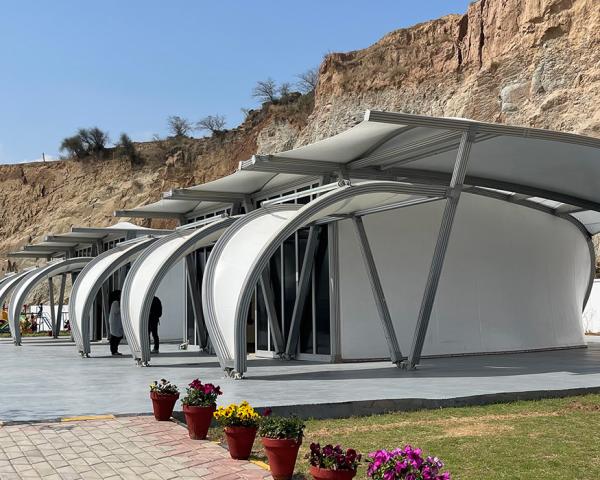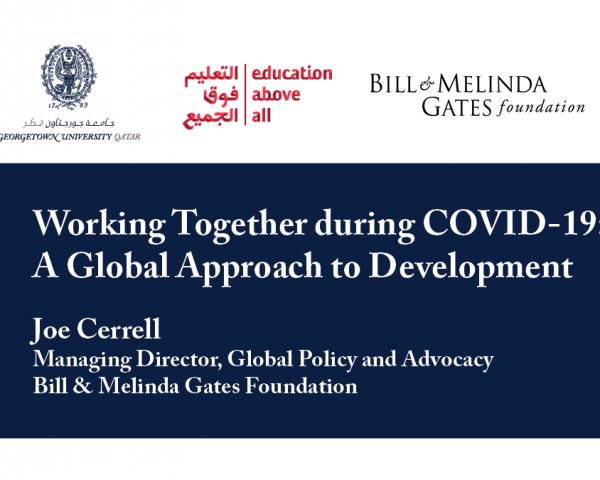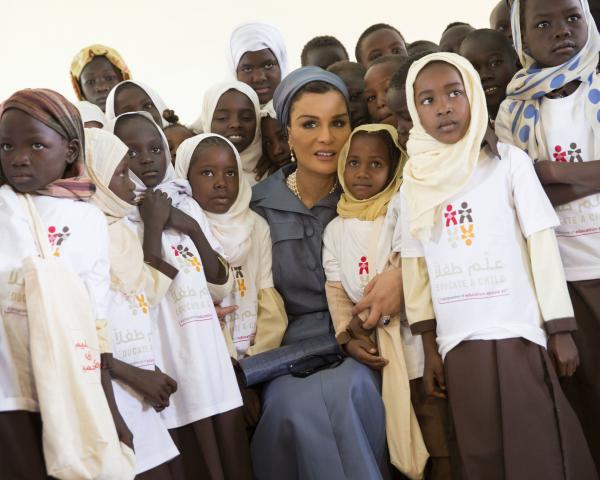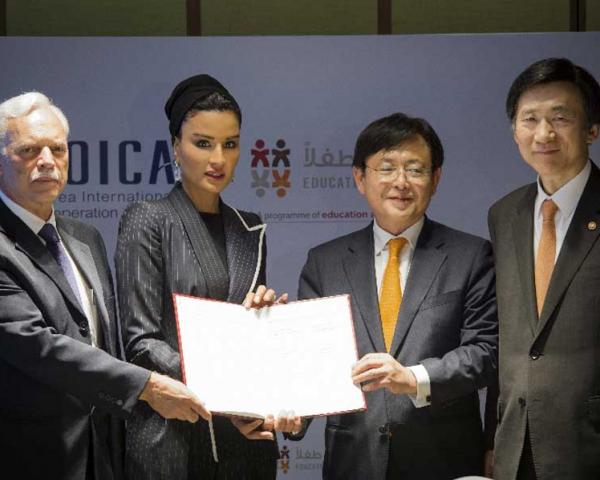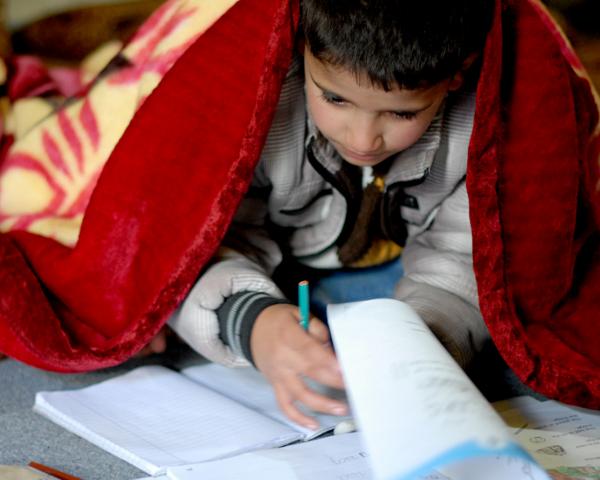GHATA II: Bringing Education to Informal Tented Settlements
Project Status
In 2012, AUB’s Center for Civic Engagement and Community Service (CCECS) designed the Ghata (meaning “Cover” in Arabic) structure, to serve as a temporary shelter that ensures humane and decent living conditions during acute weather changes and over protracted stay. On February 15, 2014, the Lebanese Ministry of Social Affairs issued a formal approval to use the Ghata model for educational purposes. Accordingly, CCECS collaborated with the AUB departments of Education, Landscape Design and Ecosystem Management, Engineering and Architecture, and Nutrition – in partnership with the Lebanese Ministry of Social Affairs and the local NGO Kayany Foundation – to initiate the project entitled ‘’GHATA: Bringing Education to Informal Tented Settlements’’.
The guiding principle of the project is to contextualize Ghata classrooms along with educational, nutritional, and psychosocial programs within the informal refugees’ landscape, and to empower Syrian teachers to lead the educational process. Ghata schools provide quality NFE programs that address some of the key challenges refugee children face in accessing educational opportunities:
• Delivery of the Lebanese curriculum in English and Arabic language;
• Close proximity of schools campuses to informal tented settlements in order to keep attendance rates high;
• Structural design specifications that ensure child-friendly spaces necessary for child protection and conducive to creating quality learning environments.
The Ghata project is also innovative in its contextualization of the intervention emphasizing an assets-based approach and building sustainable and strategic partnerships with local stakeholders and communities to meet their needs. The Ghata schools are a successful model for high-quality regulated NFE education program in the context of the Government’s RACE strategy. This is evidenced by the schools’ retention rate of 61% and students’ average academic performance of 89.25% in June 2017 final exams, as reported in ROTA intervention phase 1 annual report in June 2017, ROTA intervention phase 1.
In keeping with its commitment to increase access to education for Syrian refugee children and after receiving visits from the Ministry of Education and Higher Education and being ensured of the quality of education that the children are receiving, the ROTA-AUB Kayany Ghata schools in Majdal Anjar and Saadnayel received official accreditation. This is a significant achievement and first to be granted to an NGO providing Syrian refugee children with free and secular education. Students graduating from Ghata schools will now receive certificates that are officially recognized and accredited by MEHE and by the Ministry of Exterior, enabling them to pursue further education either in Lebanon or upon their return to Syria.
The objective of the Ghata project phase 2 aims to increase and provide access to non-formal education in the contextualized built environment with additional support of child protection services, nutritional assistance, and technology and innovation skills for Syrian refugee children to improve educational outcomes and facilitate their eventual integration back into formal education, while building capacity of Syrian refugee teachers and parents to lead the educational process. By creating safe and child-friendly learning environments and empowering Syrian teachers to deliver quality education, non-formal education is transformed to a new level. The need to increase and provide access to NFE with additional support of integrating Child Protection Services, Nutrition, and Innovation and Technology programs in the existing in non-formal education systems are detailed below:
Increasing and Providing Access to Non-Formal Education:
Education is a fundamental human right and serves as the bedrock for societal development.
The RACE II report points out that “the quality and availability of built spaces in public schools can also pose a barrier to accessing schooling” and that Syrian children are experiencing bullying and violence in Lebanese public schools. The Ghata built environment are culturally compatible schools for Syrian refugee children. The structures provide affordable, safe and reliable schools for Syrian refugee children in Lebanon in close proximity to the ITSs, serving as safe learning environments for children in alternative settings.
As mentioned above, in the Saadnayel and Majdal Anjar communities the project is targeting, the number of out of school children is 11,650 and 13,000 respectively – more than half of school aged children in these communities. Although, the Lebanese Government and UN agencies are working together to develop durable strategies to enable Lebanon to respond to the crisis, there still remains a huge need to support Syrian refugee children in their entry in formal or non-formal education programs. In 2016-2017, AUB and its local implementing partner are accommodating to 1,310 children in the ROTA intervention schools – phase 1 (Refer to tables in Appendix for breakdown of students enrolled in the schools by class).
The December 2016 on-site visit report submitted by the AUB Education Department provided insight into the continuous need for conducting follow-up sessions and additional capacity building trainings for teachers due to teacher turnover and identified gaps in adoption of optimal teaching approaches. Psychosocial Support: The war in Syria has significantly impacted the social and emotional well-being of Syrian children and families. Exposure to violence, loss, and separation from family members, neighbors and friends, deterioration in living conditions and lack of access to services has led to immediate, as well as long-term consequences on their development and psychological well-being. Findings from focus group discussions revealed that the school teachers have difficulties dealing with children who show inappropriate behaviors, such as aggression, withdrawal, stealing, cursing, hitting, lying, oversensitivity and hyperactivity, lack of attention, violence, lack of self-esteem, introversion and inability to express their feelings and emotions, lack of motivation, frequency absences, impulsivity, etc.
A recent WHO-UHCR assessment showed that 58% of Syrian refugees had feeling of fear (15% all the time), 56% were hopeless (15% all the time), 62% were uninterested in things (27% all the time), and 65% were unable to carry essential activities for daily living because of these feelings (20% all the time). Mothers described changes in the behaviors of their children, difficulties in handling them, as well as an inability to show affection . As such, education helps mitigate the psychosocial impact of violence and displacement, fosters inclusion, human rights awareness, and conflict resolution. Nutritional Assistance: Syrian refugee children represent a particularly vulnerable population group, since they are most prone to poverty, household insecurity and malnutrition.
Strong scientific evidence indicates that malnutrition among children can adversely affect their cognitive, motor and emotional development. Moreover, undernourished children tend to have lower attendance, reduced attention span and poorer academic performance compared to well-nourished children. Schools can be a site to provide school meals as well as adequate nutrition education. Research shows that school-based nutrition programs not only contribute to positive health outcomes but are also essential in improving education access and completion, and higher enrollment as parents get more encouraged to send their kids to schools when food is provided within the school setting. Up to this date, there has not been a structured school- based nutrition program targeting Syrian refugee children in Lebanon. Thus, nutrition educational intervention programs developed and implemented in the Ghata schools are based on the social cognitive theory to provide basic nutrition knowledge and promote essential hygienic practices among Syrian refugee children in an attempt to positively change their eating behaviors and nutritional status. Innovation and Technology:
According to RACE II, the curriculum currently taught in Lebanese public schools is centered more on subject-matter content rather than on competencies or skills. The Lebanese curriculum and correlated pedagogical standards, last updated in 1997, are not as learner-centered as industry-standards require, lacking a life skills base or a gender-appreciation lens. For these reasons, the integration of innovation and technology programs within structured curriculums encourage reasoning and teach the skills that 21st century students need to develop their capacities. This type of education creates critical thinkers, increases science literacy, and enables the next generation of innovators. Justification for Extending Education Operations in Existing ROTA Schools Due to the project’s success and positive impact in providing educational opportunities for Syrian refugees thus far and the importance of fulfilling our commitment to local stakeholders and the children and families in the Saadnayel and Majdal Anjar communities, together with our local partner Kayany, this proposal addresses the need to extend existing operations in the two schools, rather than seeking new funding sources for constructing a new school.
Since the start of the Ghata project, AUB and its local implementing partner have worked diligently in building and maintaining relationships based on trust and commitment with local stakeholders and authorities, as well as host communities and Syrian refugees in the Saadnayel and Madjal Anjar areas. Trust between implementing partners and key stakeholders has further developed and strengthened due to the participatory approach and consistency in coordination and service provision. Moreover, the quality of non-formal education provided at the ROTA schools, the biggest NFE schools in Bekaa, is highly recognized by the beneficiaries’ families who want to continue to send their children to the schools.
As a result, the ROTA schools have witnessed high influx in demand for enrollment, and AUB and its local partner are keen on fulfilling their commitment to the targeted communities. This approach is grounded from the lessons learned in phase 1. During phase 1, in order to respond to the high demand of students in the Saadnayel and Majdal Anjar Ghata Schools and given the expansion of refugee access to Lebanese public schools in other locations, AUB-CCECS and Kayany assembled Ghata school campuses in two locations rather than three. The Saadnayel and Majdal Anjar Ghata Schools expanded capacity with 19 Ghata classroom units, 2202 enrolled students, and 44 teachers exceeding original plans and reaching targets for beneficiaries according to grant requirements.
The two factors that led to this responsive adjustment in phase 1 project design are detailed below: 1) Demand for student enrollment from surrounding Informal Tented Settlements (ITSs) greatly exceeded expectations in Saadnayel and Majdal Anjar. In order to gain legitimacy on the ground, and on principle, it is important to meet the demand of the communities in which these schools have been established. 2) Syrian refugee access to Lebanese public schools was expanded in a number of other locations originally considered reducing need in those communities, further validating the decision to focus project efforts on Saadnayel and Majdal Anjar where the need for NFE is more acute (in line with the RACE strategy).
A major benefit of this responsive adjustment on program design and impact was improved quality management of the educational and other services provided, and deepened relationships with project partners, local communities, and NGOs in the targeted areas. We envision that in the coming 2017-2018 academic year, the schools will encounter a similar high enrollment demand, especially due to the fact that the schools are officially accredited and the current situation in Syria remains unstable. The proposed budget will allow for the project duration to run for 12 months – or one academic year, starting in September 2017, which will be mainly limited to direct school operations. In summary, this proposal is addressing the need to sustain current education operations at the existing two ROTA schools, educating 1350 Syrian refugee children, with half estimated to be new students (based on enrollment figures of new and returnees in the two schools in 2016-2017).
In addition, a one year extension of operations in the existing ROTA schools will give AUB and its local partner sufficient time to properly plan for an exit strategy to seek interested funders to sustain the school operations upon completion of the ROTA Phase 2 agreement next year. We are confident that given a 1 year project extension as requested in this proposal, we can secure a funder for the phase 1 schools. Finally, this period of time will allow for an in-depth evaluation of phase 1 informing any future proposal for additional construction of new schools funded by ROTA.







